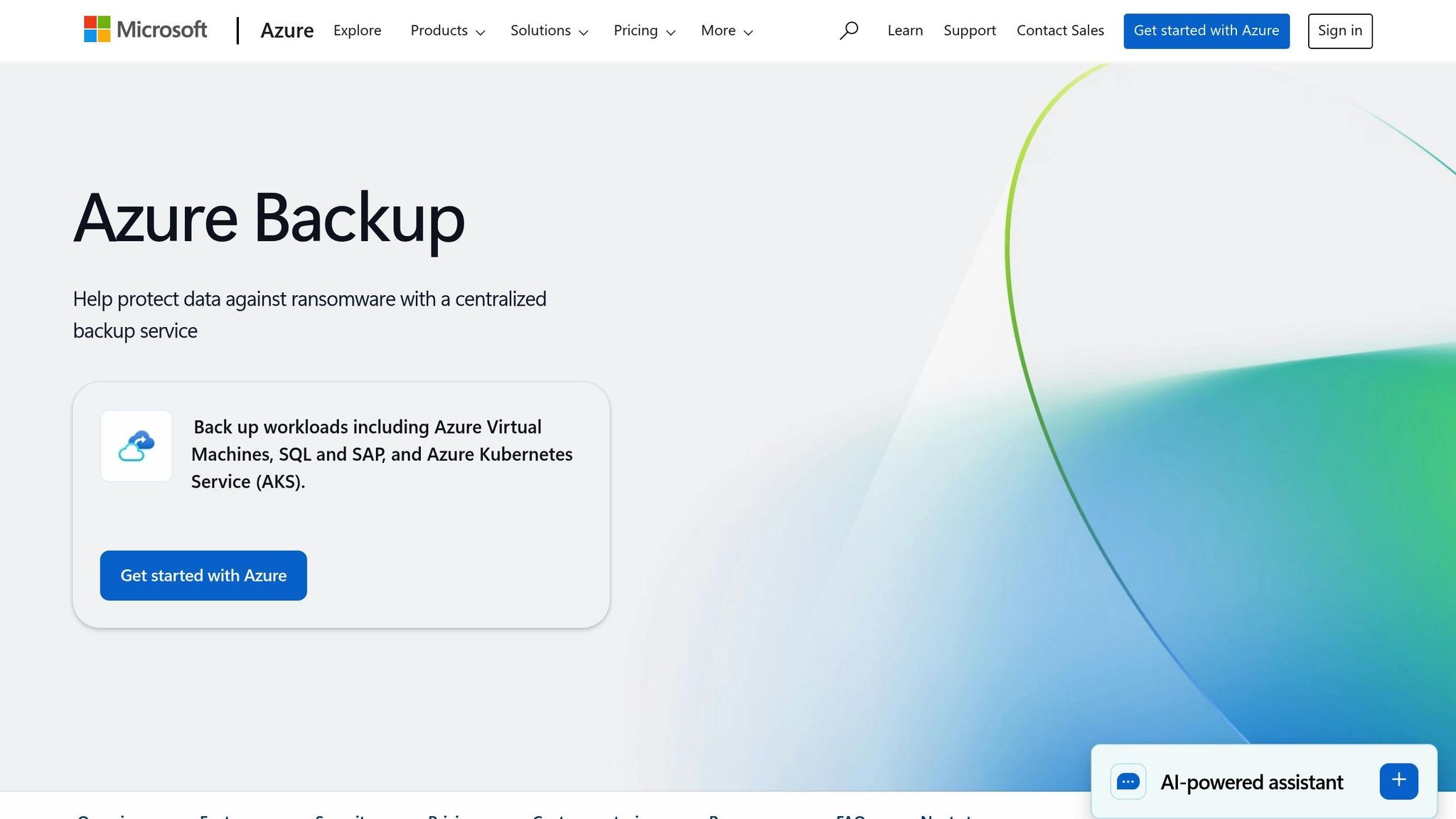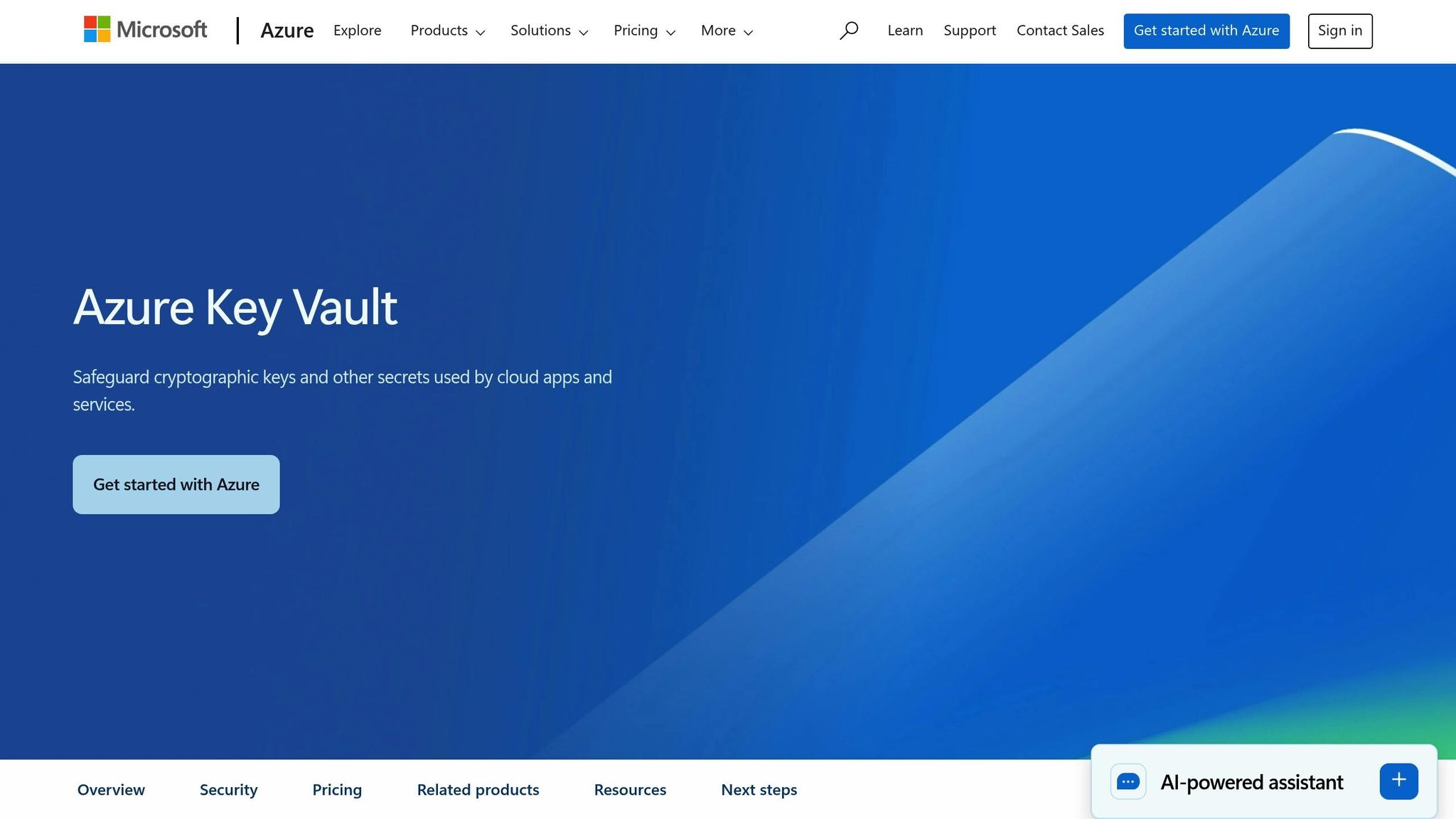Azure Key Vault: Securing Backup Keys for Compliance
Learn how Azure Key Vault helps UK SMBs secure backup keys, meet compliance standards, and protect against data loss and penalties.

Losing backup keys can cripple your business. Without them, encrypted data becomes inaccessible, leaving you vulnerable to data loss, financial penalties, and reputational damage. For UK SMBs, meeting compliance standards like GDPR, FCA guidelines, and ISO/IEC 27001 is non-negotiable. Azure Key Vault offers a centralised, secure way to manage backup keys, ensuring encryption, access control, and audit trails align with legal requirements.
Key Takeaways:
- Backup keys are critical for encrypting and recovering sensitive data.
- UK laws demand strict management of encryption keys to avoid fines up to £17.5M.
- Azure Key Vault simplifies compliance with features like Role-Based Access Control (RBAC), automated key rotation, and detailed audit logs.
- Soft delete and purge protection add a 90-day recovery window to prevent accidental or malicious key loss.
Azure Key Vault integrates with Azure Backup and Recovery Services to give SMBs control over encryption keys while reducing complexity. However, proper setup, monitoring, and cost management are essential to maximise its benefits. Learn how to securely manage your keys while staying compliant with UK regulations.
Legal Requirements for Backup Key Management
Main UK Compliance Standards
UK businesses must navigate three key regulatory frameworks: GDPR, FCA guidelines, and ISO/IEC 27001. The General Data Protection Regulation (GDPR) requires companies to securely process and store encryption keys while maintaining detailed audit trails to safeguard customer data.
Financial Conduct Authority (FCA) guidelines impose stricter measures for businesses handling financial information. These include strong authentication processes, segregation of duties, and robust data protection controls. Additionally, the FCA mandates regular reviews of key management systems, ensuring they remain effective over time. Simply setting up a system and leaving it unchecked is not enough.
ISO/IEC 27001, the international standard for information security management, reinforces these requirements. It demands documented policies for key management and secure practices throughout the key lifecycle. This ensures a comprehensive approach to encryption key security.
The practical implications go beyond just storing keys securely. Businesses must demonstrate their ability to recover from key compromises, maintain clear separations between different data types, and provide thorough evidence of compliance during inspections. Systems must automatically log every key access, rotation, and modification, creating a detailed record for audits and regulatory reviews.
Failing to meet these standards can leave businesses exposed to severe financial and reputational risks, as outlined below.
Costs of Non-Compliance
The financial consequences of failing to manage backup keys properly can be catastrophic, particularly for small and medium-sized businesses (SMBs). GDPR violations can result in fines of up to £17.5 million or 4% of annual global turnover, whichever is higher. For many SMBs, even a fraction of these penalties could lead to drastic changes or even closure.
The FCA has also shown its readiness to impose heavy fines. Recent enforcement actions for poor key management have exceeded £15 million. With the FCA ramping up its enforcement efforts, the cost of non-compliance is becoming increasingly steep.
But the financial impact doesn't stop at fines. Regulatory investigations bring significant legal expenses, and businesses are often forced to invest heavily in remediation efforts to fix underlying issues. Surveys show that 60% of UK SMBs now cite compliance as their main reason for investing in secure key management solutions, highlighting the growing awareness of these risks.
Reputational damage can often outweigh the financial penalties. Customers are quick to lose trust when their data is mishandled, leading to cancelled contracts and fewer new opportunities. Additionally, partners and suppliers are increasingly demanding evidence of robust security practices before entering agreements, meaning non-compliance can shut businesses out of lucrative deals.
| Compliance Standard | Requirements | Maximum Penalties |
|---|---|---|
| GDPR | Encryption, access control, detailed audits | Up to £17.5M or 4% of global turnover |
| FCA Guidelines | Strong controls, regular reviews, audit trails | Fines exceeding £15M |
| ISO/IEC 27001 | Secure lifecycle management, access controls, audits | Loss of certification, contract exclusion |
The operational impact of non-compliance is also significant. Staff must allocate time to responding to regulatory inquiries, conducting internal reviews, and implementing corrective measures. This diverts resources from revenue-generating activities and creates uncertainty about potential penalties.
The Information Commissioner's Office (ICO) has issued fines ranging from tens of thousands to millions of pounds for data breaches linked to poor key management. These cases underline the critical importance of backup key security as a cornerstone of data protection, not just an optional extra.
Steps to take Azure Backup and Encryption with Key Vault Service

Using Azure Key Vault to Secure Backup Keys

Azure Key Vault offers a streamlined way for small and medium-sized businesses (SMBs) to manage their backup keys while staying compliant with regulations. Instead of relying on scattered systems or expensive on-premises hardware, companies can centralise their encryption infrastructure using Microsoft's cloud-based service.
Central Key Management
Azure Key Vault serves as a secure, centralised hub for managing encryption keys, secrets, and certificates. This setup avoids the risk of secrets being spread across various systems. For UK-based SMBs dealing with numerous compliance requirements, having everything in one place is a game changer.
The platform simplifies operations by ensuring only authorised users and services can access sensitive data when needed. When a key or secret in Key Vault is updated, all connected services automatically adopt the latest value. This reduces manual work and minimises the risk of errors. This level of automation is especially helpful for smaller teams that may lack the resources for hands-on key management.
Additionally, Azure Key Vault removes the need for in-house expertise in hardware security modules (HSMs). Microsoft handles the complex security infrastructure behind the scenes. This allows SMBs to access enterprise-grade protection without the high costs or technical challenges that typically come with it. By combining centralised management with strong security measures, the service ensures optimal protection for your encryption keys.
Security and Compliance Features
Azure Key Vault addresses compliance challenges with a robust set of security features. Role-Based Access Control (RBAC) ensures that access to keys and secrets is limited based on specific user roles. Meanwhile, detailed audit trails log every activity, offering transparency and accountability. This granular control supports the principle of least privilege, as required by GDPR and the Data Protection Act 2018.
The detailed logs also provide the documentation regulators in the UK expect during inspections. Every key access, rotation, and update is recorded, creating a comprehensive audit trail that speeds up incident response and supports compliance with backup key management standards.
Key Vault's "soft delete" and purge protection features prevent accidental or malicious deletion of keys and secrets. With a default recovery period of 90 days, businesses have enough time to detect and address potential issues before any permanent loss occurs.
For added resilience, Azure Key Vault includes automatic redundancy and failover, replicating data across multiple regions. This ensures high availability and minimises downtime, offering peace of mind to businesses that rely on uninterrupted access to their data.
Working with Azure Backup and Recovery Services
Azure Key Vault integrates effortlessly with Azure Backup and Recovery Services, allowing users to manage customer-controlled keys for encrypting backup data. This integration ensures that SMBs retain full control over their encryption lifecycle, meeting regulatory demands for customer ownership of encryption processes.
Through this setup, the Backup Management Service app retrieves encryption keys directly from the Key Vault, allowing businesses to maintain control while benefiting from cloud-based backup solutions. This approach satisfies compliance frameworks requiring businesses to oversee their encryption keys while leveraging the convenience of Azure's backup services.
The service's centralised management and automation features have been shown to reduce security incident response times by up to 75% for organisations. Automated key rotation and RBAC enforcement not only enhance security but also help SMBs navigate compliance audits more smoothly, often with fewer findings.
Azure Key Vault also supports key rotation and rekeying - essential practices for maintaining encryption compliance and reducing vulnerabilities. Automated rotation schedules keep keys up to date without manual effort, minimising human error and ensuring compliance with regulations that require periodic key updates.
For SMBs looking to balance costs with security, resources like Azure Optimization Tips, Costs & Best Practices offer practical advice on scaling operations securely within Azure while adhering to compliance standards. Up next, explore how to set up and fine-tune Azure Key Vault to maximise the security of your backup keys.
How to Set Up Azure Key Vault Correctly
Setting up Azure Key Vault requires careful planning, strong policies, and reliable automation to keep backup keys secure and compliant.
Create Key Management Policies
A solid key management policy is the backbone of a secure Azure Key Vault setup. It's best practice to have one Key Vault per application, region, and environment. This approach reduces the impact of a potential security breach - if one vault is compromised, the damage is contained.
For UK small and medium-sized businesses (SMBs) managing multiple tenants, it's crucial to use separate Key Vaults for each client. This ensures that client keys remain isolated and complies with the Data Protection Act 2018.
Automated key rotation every 90 days is essential. It not only keeps keys fresh but also reduces the need for manual intervention. Additionally, enforcing split key responsibility ensures no single person has complete control over critical encryption keys, which adds an extra layer of security.
When setting Role-Based Access Control (RBAC) policies, follow the principle of least privilege. For instance, backup operators should only have permissions to back up and restore keys, while senior administrators handle key creation and deletion. Document these policies thoroughly and review them every quarter to keep them aligned with UK compliance standards and your organisation's evolving needs.
Configure Backup and Automation
Once policies are in place, focus on backup and automation to ensure security and continuity. Deploy multiple Key Vaults across Azure regions to improve business continuity and provide fast access for distributed teams. These vaults should sync automatically to maintain consistent access policies and protect critical keys.
Using managed identities is a secure way to automate access to your Key Vault. System-assigned managed identities work well for single applications, while user-assigned identities offer more flexibility for complex setups. By avoiding the need to store credentials in code, these identities significantly reduce security risks.
Automation scripts - whether written in PowerShell or Azure CLI - can simplify routine tasks like key rotation and backup. Running these scripts during off-peak hours minimises disruption, and adding alert mechanisms ensures administrators are notified of any failures or unauthorised access attempts.
To further safeguard your vaults, enable soft delete and purge protection. These features provide a 90-day recovery window, reducing the risk of accidental or malicious deletions.
Track and Review Key Usage
After setting up and automating your Key Vault, it’s important to monitor and review key usage regularly. Detailed logging should capture all interactions with the vault, creating an audit trail that meets compliance requirements. Enable diagnostic settings to record key operations - such as access attempts, rotations, and policy changes - and integrate these logs with your Security Information and Event Management (SIEM) solution for centralised monitoring.
Review access policies periodically to identify any security gaps, redundant permissions, or unusual patterns. For example, look out for keys that haven’t been accessed for a long time or access attempts during odd hours, as these could indicate compromised accounts. Organisations using automated key rotation have reported a 75% reduction in security incident response time, highlighting the importance of proactive monitoring.
Usage analytics can also reveal opportunities for improvement, such as consolidating underused vaults or identifying keys that would benefit from automated rotation. Regular reviews ensure that access permissions are updated promptly - for instance, removing access for departing employees or granting it to new team members without delay.
Finally, set up automated alerts for suspicious activities, such as multiple failed access attempts, access from unexpected locations, or attempts to delete critical keys. These alerts enable quick responses to potential threats while helping you meet compliance requirements.
For more tips, check out Azure Optimization Tips, Costs & Best Practices.
Benefits and Drawbacks of Azure Key Vault
Once you've set up your Key Vault, it's time to take a closer look at its strengths and potential challenges. For UK SMBs managing backup keys, Azure Key Vault offers a range of advantages, but it’s crucial to weigh these against any operational hurdles before diving in.
Comparing Benefits and Challenges
Choosing Azure Key Vault means balancing its powerful security features and compliance benefits with the complexities of management and associated costs. For instance, automated key rotation can reduce incident response time by up to 75%, showcasing its efficiency gains. However, SMBs should also factor in potential learning curves and ongoing expenses.
From a security standpoint, Azure Key Vault offers robust protection through hardware security modules (HSM), helping to eliminate the issue of "secret sprawl" across systems. Additionally, its soft delete feature safeguards against accidental or malicious deletions, a critical benefit for UK SMBs needing to meet GDPR and Data Protection Act 2018 requirements.
Cost considerations are tied to usage. For moderate needs, monthly costs typically range between £10 and £50, while larger deployments can cost £50–£200. Standard operations are priced at approximately £0.03 per 10,000 operations, with HSM-protected keys costing £0.15 per 10,000 operations.
Here’s a quick breakdown of the benefits and challenges:
| Benefits | Drawbacks | Impact on UK SMBs |
|---|---|---|
| Centralised secret management reduces complexity | Setup can be challenging without cloud expertise | May require hiring consultants or investing in staff training |
| Automated key rotation strengthens security | Pay-as-you-go pricing can result in unexpected expenses | Monthly costs vary from £10 to £200 depending on usage |
| Audit logs help meet compliance standards | Legacy system integration may demand custom development | Additional time and development costs |
| Soft delete and purge protection offer a recovery window | Continuous monitoring is essential to maintain security | Requires dedicated staff for ongoing management |
| Role-based access control (RBAC) and managed identities provide precise access control | Steep learning curve for least-privilege access implementation | Staff training is necessary to avoid missteps |
| Scalable across regions and environments | Misconfigurations can lead to security risks | Proper expertise is critical to avoid gaps |
While Azure Key Vault delivers clear security and compliance benefits, the complexities involved in setup and management shouldn’t be underestimated. For SMBs with limited cloud expertise, configuring role-based access controls or integrating the service with existing systems can be particularly demanding. The pay-as-you-go pricing model, while flexible, requires close monitoring to prevent unexpected costs.
For businesses handling sensitive backup keys, the advantages of Azure Key Vault often outweigh these challenges. However, the success of its implementation hinges on ensuring your team has the necessary skills or external support to manage the service effectively.
To better manage Azure costs and optimise your Key Vault setup, check out Azure Optimization Tips, Costs & Best Practices for expert advice tailored to SMBs scaling their operations on Microsoft Azure.
These insights can help you align Azure Key Vault with your broader compliance and security goals.
Meeting Compliance Goals with Azure Key Vault
For UK small and medium-sized businesses (SMBs) navigating strict regulations, Azure Key Vault offers a practical solution that transforms backup key management into a valuable asset. It addresses the key challenges SMBs face when working to comply with standards like GDPR, ISO 27001, and PCI DSS, all while maintaining smooth day-to-day operations. This shift turns what could be a compliance headache into a strategic advantage.
Azure Key Vault simplifies key management by centralising it, solving the issue of "secret sprawl" - where backup keys and sensitive credentials are scattered across various systems. By consolidating everything into a single, secure hub, businesses gain a clear point of control for all cryptographic materials.
Beyond centralisation, the platform offers automated tools like audit logs, role-based access control (RBAC), and managed identities. These features not only reduce manual tasks but also protect businesses from hefty non-compliance penalties. With financial fines for breaches being significant, Azure Key Vault’s security controls and audit capabilities provide critical safeguards. Additional features, such as soft delete and purge protection, add an extra layer of security by offering a 90-day recovery window for deleted keys.
For SMBs, Azure Key Vault is designed to grow alongside their business. Whether managing a small number of keys or thousands, its customer-managed key functionality ensures businesses can maintain control over encryption materials while meeting data sovereignty requirements with ease.
Azure Key Vault also integrates seamlessly with Azure Backup and Recovery Services, creating a unified system where backup data encryption aligns automatically with organisational security policies. This integration simplifies configurations and ensures consistent compliance across all backup operations.
To maximise the benefits of Azure Key Vault, SMBs can explore expert resources for guidance on cost management and best practices. For actionable advice, check out resources like "Azure Optimization Tips, Costs & Best Practices" (https://azure.criticalcloud.ai), which provide practical insights to enhance compliance and operational efficiency.
FAQs
How does Azure Key Vault help UK businesses meet GDPR and FCA compliance requirements?
Azure Key Vault offers a secure way for UK businesses to manage cryptographic keys, secrets, and certificates, helping them meet GDPR and FCA compliance requirements. It protects sensitive data with strong encryption, strict access controls, and comprehensive audit logging - key elements for aligning with UK regulatory standards.
By centralising key management and automating security-related tasks, Azure Key Vault reduces the complexity of compliance. This not only helps businesses stay in line with privacy and data protection laws but also supports smoother, more efficient operations.
How does Azure Key Vault protect backup keys from being accidentally or maliciously deleted?
Azure Key Vault offers strong safeguards to prevent the accidental or intentional deletion of backup keys, thanks to features like soft delete and purge protection. With soft delete, any deleted keys are kept in a recoverable state for a specific period, giving you the option to restore them if required. Purge protection goes a step further by blocking permanent deletion unless explicitly authorised. These measures enhance security, support compliance requirements, and minimise the risk of losing critical data.
How can small and medium-sized businesses use Azure Key Vault to enhance security while managing costs effectively?
SMBs can get the best out of Azure Key Vault by adopting smart strategies that balance security with cost efficiency. Start by reviewing access policies regularly to ensure that only authorised users have access. Adjust these permissions as roles or requirements change. Another cost-saving measure is to tidy up key management by removing unused keys and avoiding the creation of unnecessary secrets.
Azure's built-in cost management tools are also a handy resource. Use them to track your usage and spot opportunities to cut costs. Adopting a Zero Trust security model is another effective way to enhance security without adding extra expenses. Lastly, make it a habit to consistently monitor and audit your Key Vault usage. This helps ensure compliance, prevents overuse, and keeps your security strong without breaking the bank.




